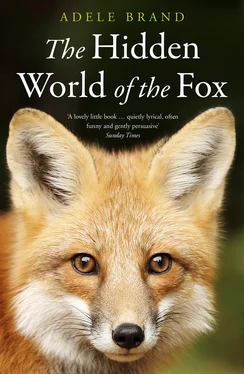
© Prince Hanzoku Terrorised by a Nine-Tailed Fox, Utagawa Kuniyoshi (1798–1861) (Wikimedia Commons)
A nine-tailed kitsune in nineteenth-century Japanese art.
Later, as humanity discovered the joy of story-telling, foxes joined the cast. The oral literature of native Americans occasionally opts for a fox as a trickster, albeit a potentially handy one; according to one Apache legend, it was Fox who stole fire from the fireflies and introduced it to Earth. It is across the Pacific in Japan, however, that fox folklore reaches its most astounding heights. Kitsune – the revered fox of Japanese myth, poetry and traditional belief – has existed in human thoughts for many centuries. It even makes an appearance in what may be the world’s oldest novel: the eleventh-century epic The Tale of Genji, where a human character debates whether the figure by a tree is a woman or a shapeshifting vulpine. Kitsune delight, deceive and confuse in countless other legends; while the theme of pretending to be an attractive woman is frequent, other tales relive how they mislead travellers by lighting ghost fires at night, assume the form of cedar trees, or even become the guardian angels of samurai. Today, anime writers continue the kitsune tradition.
BACK IN EUROPE, by Roman times the uneasy relationship between foxes and agriculture had woven itself into religious rituals – in the festival of Cerealia, for example, live foxes were released into the Circus Maximus with burning torches tied to their tails. Seven hundred years later, Aesop’s tales also provide a nod to fox interactions with farmers, and – to a lesser extent – with their neighbouring wildlife. My favourite Aesop fable features a wolf taking a fox to court for theft; given the vast quantity of wolf-killed carrion that real foxes consume, it seems vaguely reasonable.
Old English literature picks up similar themes. The Fox and the Wolf, a rhyming poem from the thirteenth century, stars a fox who helps himself to some chickens and then tricks a wolf into taking the blame:
A fox went out of the wood
Hungered so that to him was woe
He ne was never in no way
Hungered before half so greatly.
He ne held neither way nor street
For to him (it) was loathsome men to meet
To him (it) were more pleasing meet one hen
Than half a hundred women.
He went quickly all the way
Until he saw a wall.
Within the wall was a house.
The fox was thither very eager (to go)
For he intended his hunger quench
Either with food or with drink
And so it continues, with the hungry fox trapping himself in a well before deceiving a wolf named Sigrim into taking his place. Ironically, this poem was written about the same time that the wolf’s howl was finally falling silent in southern Britain.
Did the fox notice the disappearance of its distant relative? Perhaps, unconsciously. As shown in Białowieża and elsewhere, the wolf was a provider as well as rival, a powerful force in the wildwood whose absence has changed these islands as much as a spoke missing from a wheel. Some species have sharply increased, and others have probably declined.
Yet civilisation has done more than simply rip out culturally troublesome natives while boosting deer and grouse for hunting. We have released millions upon millions of non-native animals into the countryside: rabbits from Spain, fallow deer from Persia, sheep from Mesopotamia, hens from south-east Asia, cats from Africa. Our trading ships accidentally added black rats from India and house mice from the Middle East, while American grey squirrels, Japanese sika deer and even Australian red-necked wallabies joined our countryside from zoos. We have persuaded ourselves that the six million sheep of Scotland are part of the ‘natural’ scene, but the Highland ecosystem evolved with none. Even the Scottish red deer population of 300,000 is far higher than in the time of the wolf. These changing grazing pressures affect the rodents and berries that foxes eat, and near-total deforestation has altered their territory sizes and feeding habits.
In a flash of geological time, we have rewritten the fox’s wildwood, in ways both graphic and subtle. We have added, taken away, replanted and concreted.
And the fox that once played its natural dodgems with the rest of the natural web will inevitably interact with the components of the new Britain that we have designed without ecological aforethought.
The fox is not an intruder into our world.
We have simply laid our modern ambitions over the landscape it already knew.

3
Where Do Foxes Live?
OPEN-TOP TOURIST BUSES and impatient black taxis battle for territory in the concrete canyons of central London; beside the gridlock, cyclists squeeze past wary pedestrians, and silent women push today’s Metro into the hands of freshly arrived train passengers. The city’s heart is within the embrace of the two highest towers of British justice: the Royal Courts with its soaring gothic spires and vaulted archways, and the Old Bailey, centuries-old theatre of the grimmest human drama. Perhaps it is no surprise that such a place tries to judge foxes too.
Humanity floods the senses. It’s noisy, so noisy, with cars, and drills, and cries of ‘Can I interest you in a …’
Salesmen offering free organic yoghurt samples, those you can escape; not the smell of vehicle exhaust, however, nor the tourists agog at military statues that screen out so much of the sky. It is musty yet grand, the mood here: intimidating, disconnecting and mesmerising. It is the bones of something; British history, perhaps, stacked so high over press crews hoping to witness more of it, while a tiny old man tries to photobomb them – his Staffordshire bull terrier is wearing a jacket emblazoned with anti-nuclear slogans.
For British people, these streets are a hook from which we dangle and debate our civilisation. For British foxes, this is a land of nothing.
Truly, nothing at all. Not a blade of grass, not a mouse, and hardly a bird in the sky. The ancient wildwood has been utterly extinguished.
At least, all logic would say so.
Yet there was a fox in this very place, not many hours past – a single scat has been deposited on a sprawling gum-spotted pavement between a bus shelter plastered with anti-police propaganda and the unsmiling security fence of the Royal Courts of Justice; a homeless man begs for coins from a populace oblivious to both wildlife and him. Over towards City Thameslink, where wet concrete was recently laid to tidy some aberration, a fox footprint is written literally into London’s frame.
That foxes thrive in leafy suburbs, wooded gardens, and even fields radically transformed by intensive agriculture is not news. But the Strand is a frontier beyond most living things. Faded carvings of red squirrels brighten one business’s wooden sign, while the tavern’s name leaves no doubt that cockfighting once brought brawls and gambling within a street-sweeper’s walk of the Inner Temple. But there is not much non-human life today, save for the pigeons where tourists break the law and feed them, and a gull or two chortling from the spires.
And a fox, somewhere.
When people exclaim that foxes are everywhere, they are both correct and imprecise. The Mammal Society’s National Mammal Atlas shows fox records in nearly every British grid square, from Cornwall to Sutherland, the Cambridgeshire fens to the Western Highlands. They are absent from the remotest islands, but mainland Britain is unquestionably the domain of the fox.
Читать дальше













